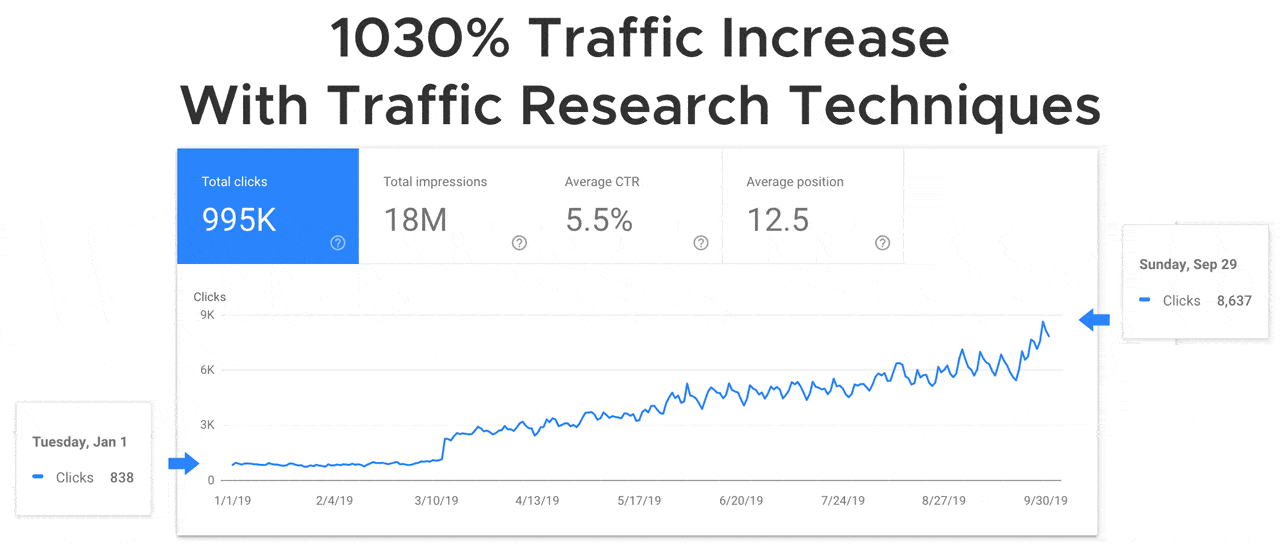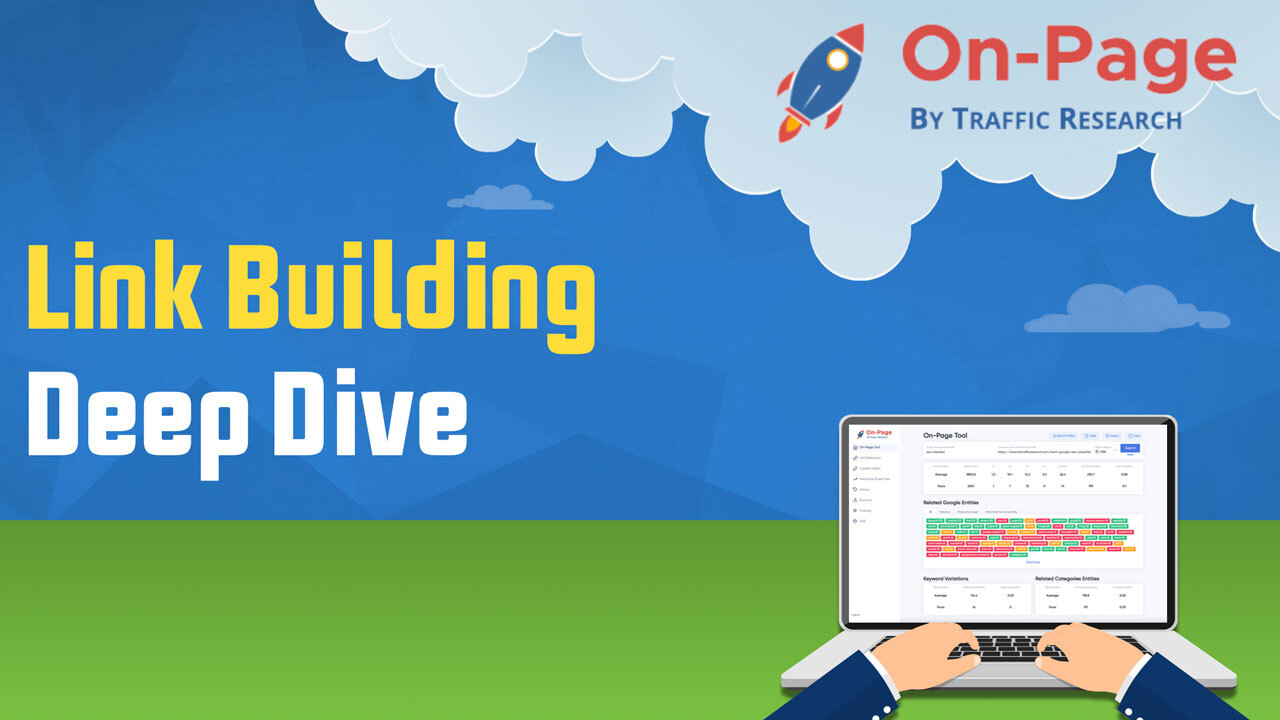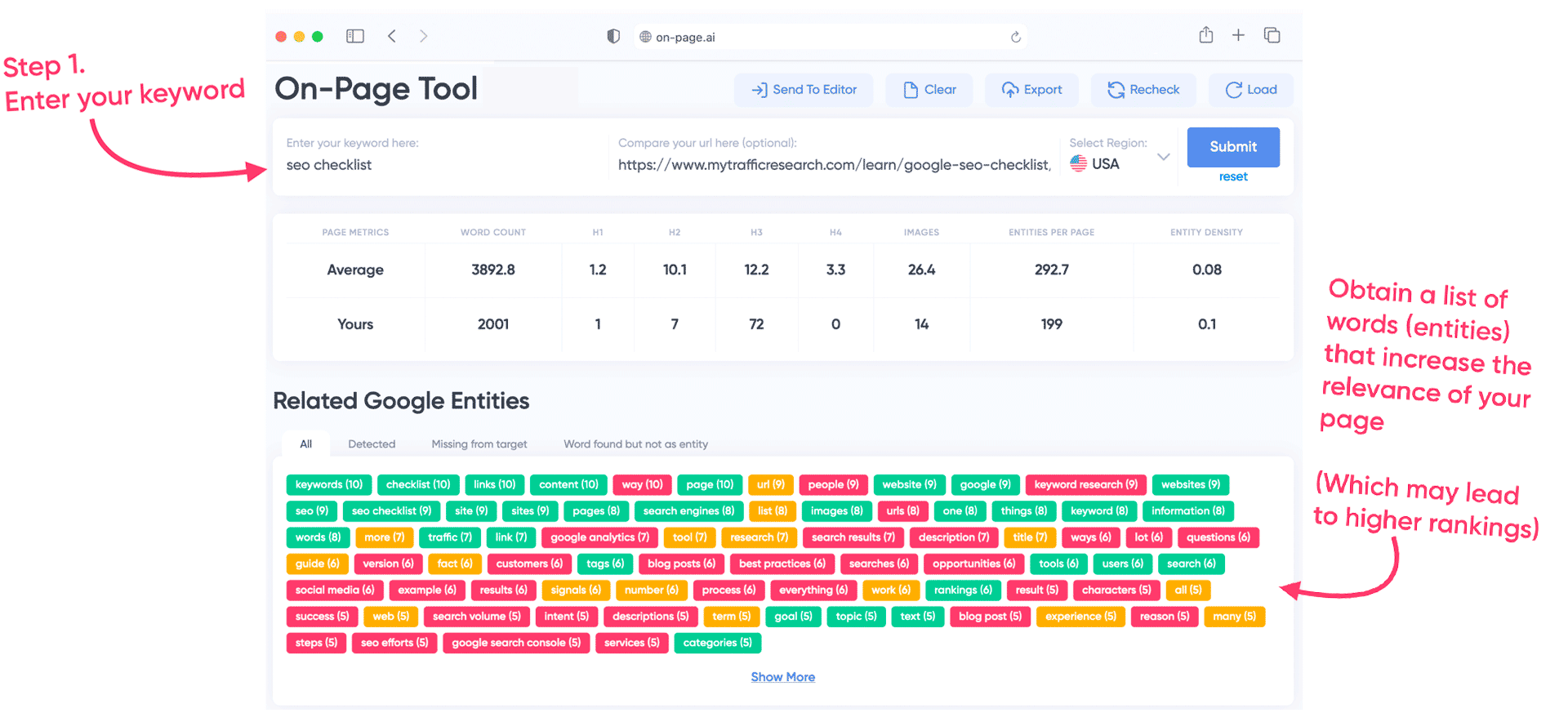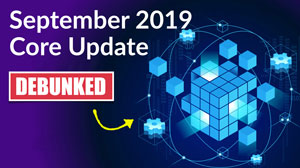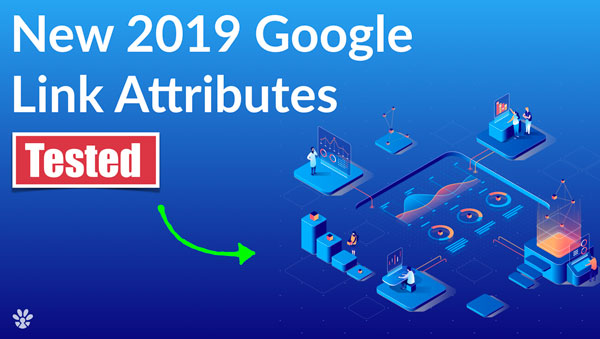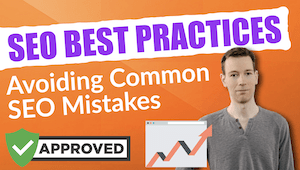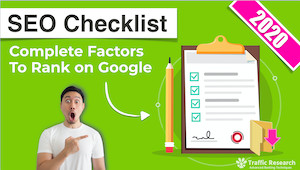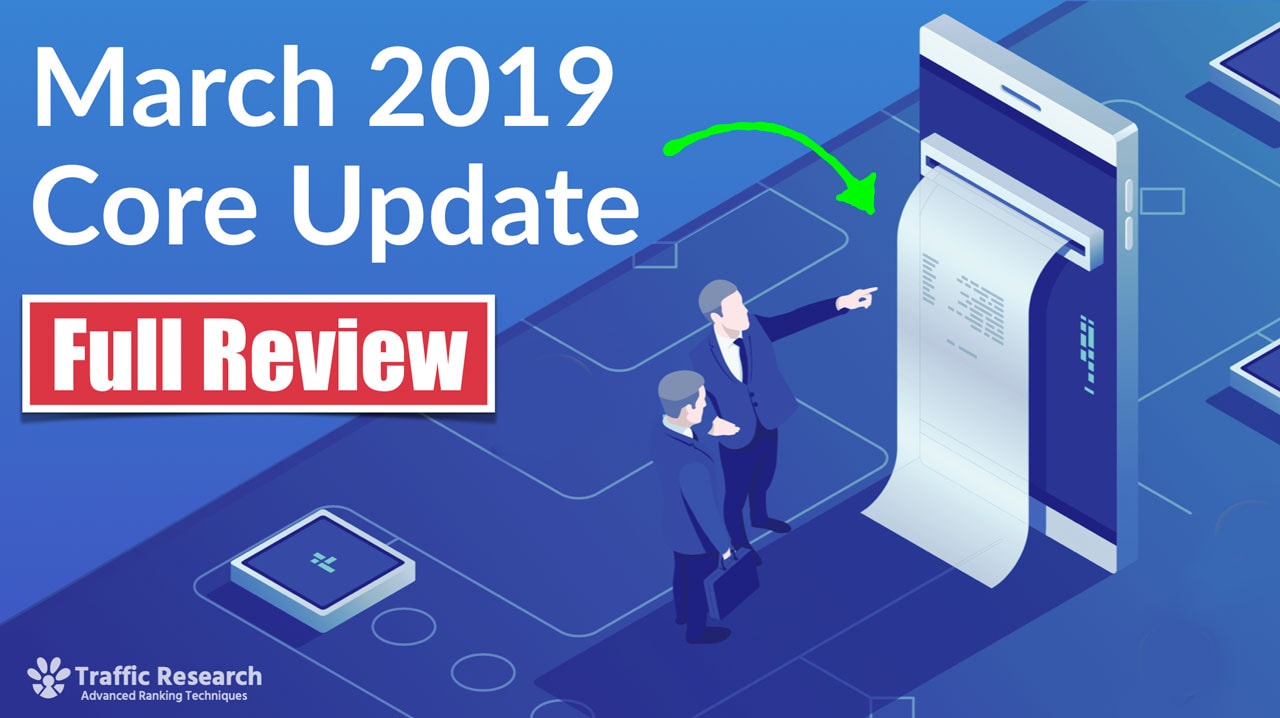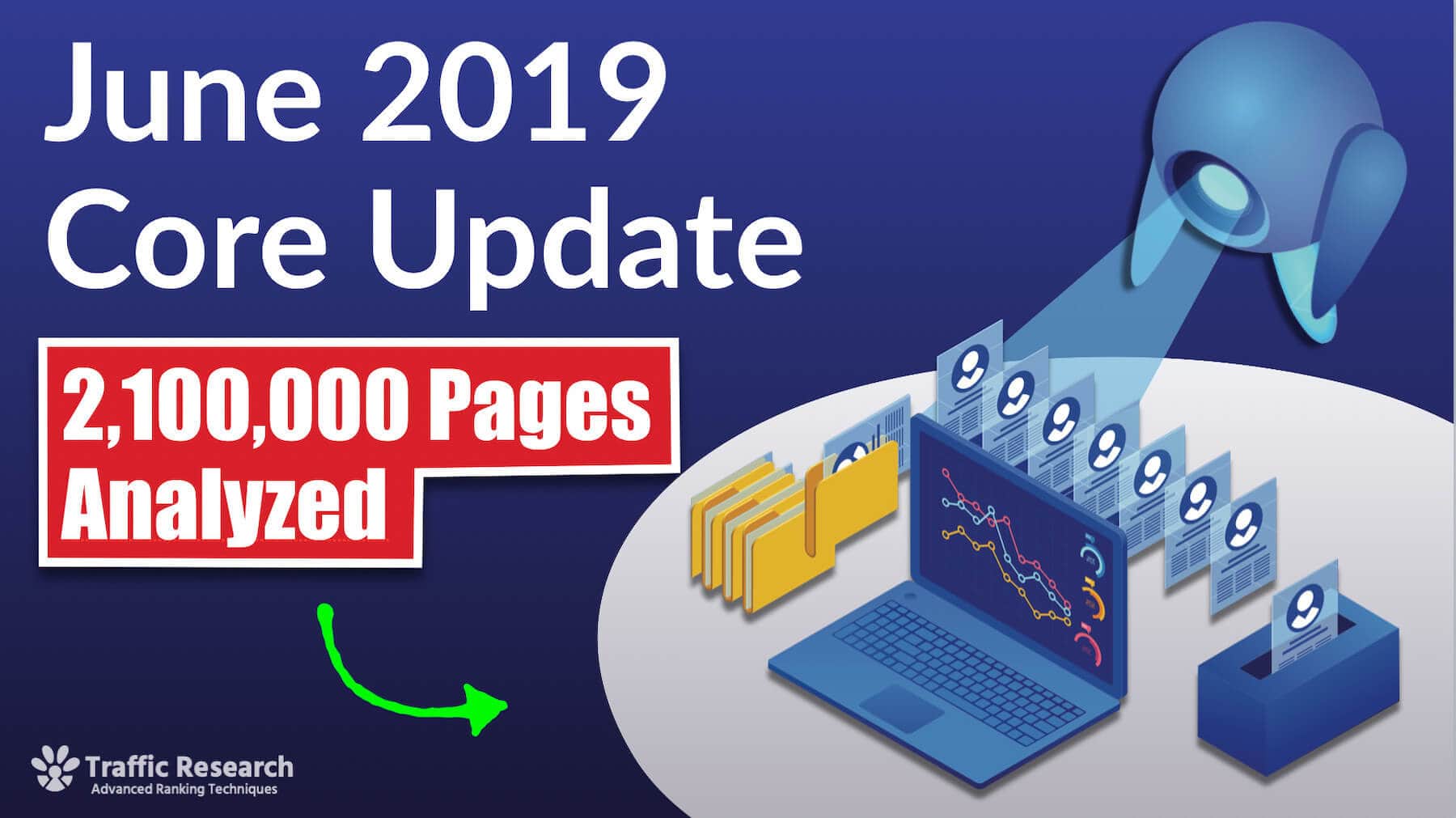Google's September 2019 Core Update - Full Analysis Of Over 6,600,000 Pages
- by Eric Lancheres Oct 10th, 2019
If you've been negatively impacted by the latest September 25th (or even the Oct 3rd) 2019 core update by Google, then you won't like what I have to say.
If you're here because you geek out on graphs, you won't like what I have to show you.
However, if you're here to learn what really changed in September 2019, so you can recover a website, stay safe moving forward or even gain a measurable advantage over your competition, you're at the right place.
Google has been making changes to the algorithm that go beyond just the front-facing link and on-page metrics...
And instead, they are refining the details within their algorithm which can sometimes have a major impact on search visibility.
Small Google tweaks, big consequences.
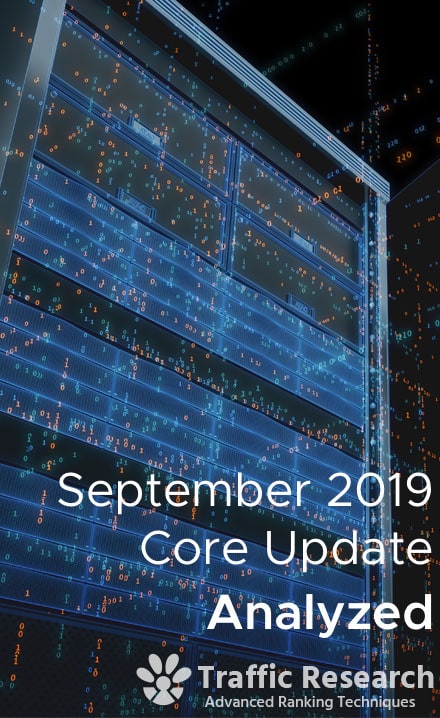
Preamble
My analysis combines data from multiple sources (both external and in-house) and I use a wide array of tools (custom and third party) to process it. If you would like to submit additional data or request data to be removed, please contact me.
Any Google Search employees that would like to submit corrections or refute any information here are also welcome to contact me.
For the Sep 2019 update, I used:
- Over 6,600,000 search results
- Over 11,000 individual keywords
- Over 570 factors
- Detailed overview of 64 Google Analytics accounts.
And of course, the user-submitted sites, traffic graphs and testimonials from our community. (thanks!)
While the raw data is irrefutable, it is important to note that correlation does not imply causation. The objective is to use the data to support or disprove theories about the September 2019 update.
Rant: It still boggles my mind that people can look at a graph that shows a 200%+ increase in links and then claim that the update had nothing to do with links.
The one thing I appear to have proven with the June algorithm is that there is a clear, proportional, correlation with the size of your website & the size of your ego.
While I encourage discussion, different opinions and counter-arguments, please support them with facts (or at the very least, historical data / plausible ideas). If your solution to an algorithmic update is to write nasty letters about Google, you're never going to recover.
The Relationship With The June Update
Early discussion within forums, blog comments, and Facebook threads hinted at the idea that the latest September update is might be related to the June core update. Quite a few webmasters that were negatively impacted by the June update saw some, or all, of their traffic bounce back after the September update.
Historically, we've seen this pattern over and over again...
1. Google releases an update with unintended consequences.
2. Trusted "white hat" sites with good content are negatively impacted.
3. Google tweaks and reworks their algorithm to account for the edge cases.
4. Faith in humanity Google is restored.
The September update appears to be Step 3, the tweaking and reworking of the algorithm to account for edge cases.
As such:
- If you were meant to be hit with the original June update, you gained no traffic.
- If you were unintentionally hit by the June update, you likely saw a partial or full recovery.
- If you were missed by the June update (but intended to be hit), you might have been affected by the latest September update.
Regardless of your situation, remember that Google is just an algorithm. I don't care what your site is, the niche that you're in or region where you're from, if you've been impacted, you can recover...
As long as you satisfy Google's algorithmic requirements.
- The Core update officially rolled out on September 25th 2019.
- The second, unannounced part of the Core update occurred on Oct 3rd 2019
- Some sites affected by the June 2019 Core update saw a recovery while other sites were impacted for the first time.
Edge-Case Traffic Recoveries
Let's start with the good news. The September update seems to have helped "edge case" websites that were negatively affected by the June update.
This re-enforces the concept of both updates are strongly related.
 Ahrefs organic traffic of www.nuffieldhealth.com
Ahrefs organic traffic of www.nuffieldhealth.com
The Nuffieldhealth traffic recovery is interesting because it's in the health niche which was famously impacted by the previous update.
Taking a closer look at the content, I notice that the site contains relatively generic & low-quality articles. Captured on the right-hand side is an example of a blog article recently posted on Nuffieldhealth. (Full disclosure, not ALL the articles on the site are like this.)
While there is nothing glaringly wrong with the content, it's certainly not any better than existing content on the same subject. There is no context, no additional information, no images, no author, no references, nothing!
Just a generic 850-word article using a keyword as the title.
Yet... this site was rewarded by Google.
This further supports the argument that the June/September/Oct updates have little to do with on-page characteristics of your content.
It does, however, have an impressive amount of trusted authority links pointing to it.
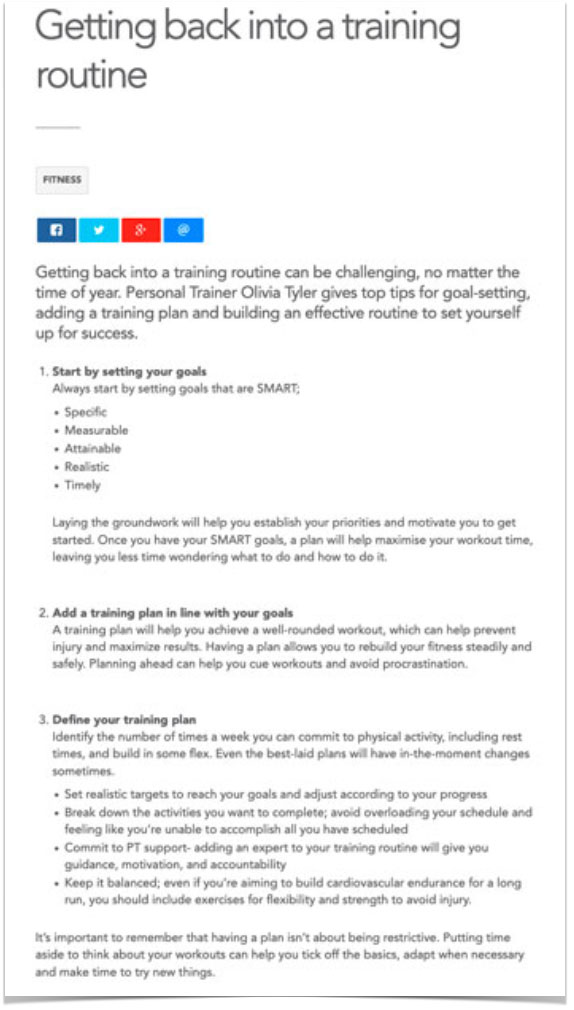
Generic article found on Nuffieldhealth.com
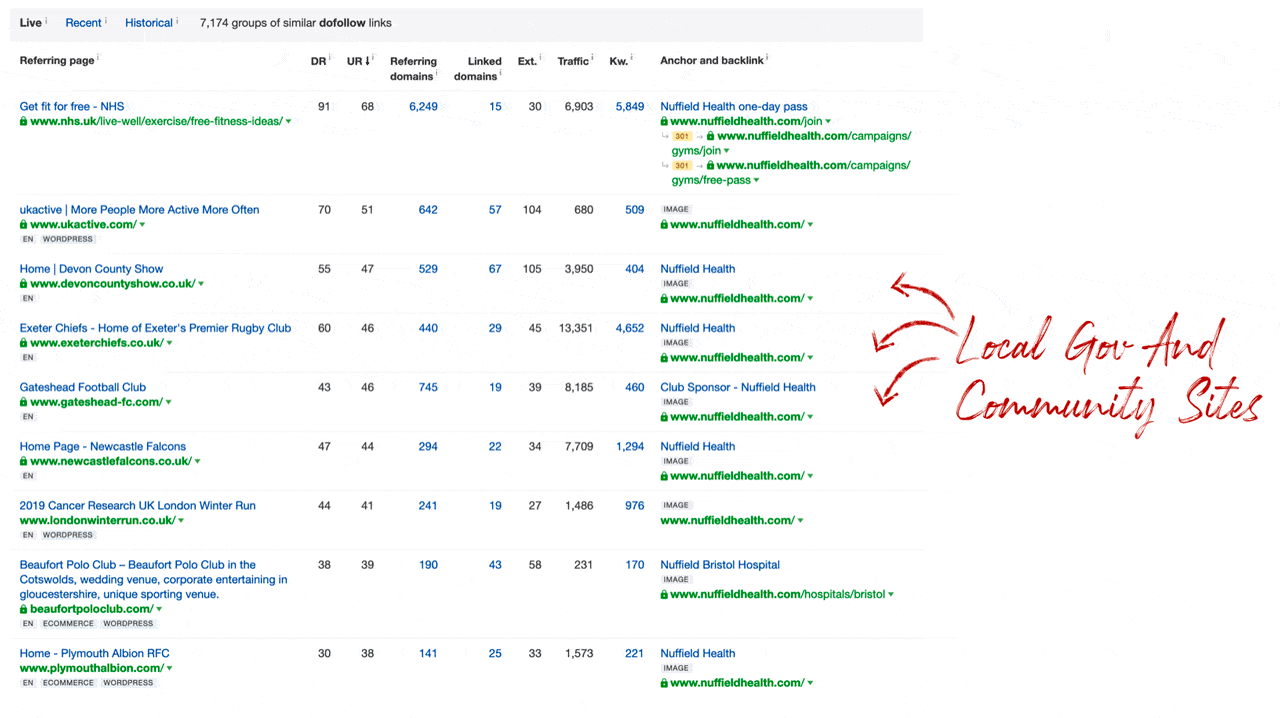
The links above are SUPER interesting because they are all:
A) From the homepage.
B) From seemingly unrelated sites.
At first glance, it could appear as if it was a series of PBNs with homepage links used to power up the domain. I'm quite sure that's what the previous algorithm thought (and why it was incorrectly penalized) as this would be an edge case that Google would not have had considered.
Of course, as humans, we can tell that these are real authority sites and they are related (by region) so Google is making the right call here to recover the site. Further on, I'll argue that the September update refined it's detection algorithm, allowing it to better distinguish the difference between real and fake links patterns.
Incorrectly Penalized Sites Recovering
If that wasn't enough to convince you that the latest September algorithm was related to the June one, here are a few more full and partial recoveries from various websites.
 Ahrefs organic traffic of www.windowslatest.com
Ahrefs organic traffic of www.windowslatest.com
Digging into the anchor text distribution of Windows Latest, we see a relatively high percentage (32%) of incoming links with the anchor text: "Windows Latest".
While humans will understand this as being the natural consequence of naming your sites "WindowsLatest.com", it's plausible that the June algorithm incorrectly penalized the site because it thought it was abusing the anchor text "Windows Latest".
 Ahrefs anchor text distribution of www.windowslatest.com
Ahrefs anchor text distribution of www.windowslatest.com
It's possible that Google confused its name, Windows Latest, for a keyword with commercial value. Thus, the Google algorithm thought they were over-optimizing for the keyword "Windows Latest" when in reality, the site was receiving natural links for their name.
This highlights two things:
- Webmasters will want to be wary when using an exact match keyword as their domain as it can potentially lead to issues when the site begins to attract natural links. (However, it might still be a valuable strategy if your site does NOT attract natural links.)
- Google seems to make the distinction between a commercial keyword and a non-commercial keyword... being much more severe for keywords with a high commercial value.

Source: Ahrefs organic traffic chart for dailymail.co.uk
Dailymail.co.uk saw a partial (almost full depending on where you start counting) recovery. Could this also have been due to Google considering the anchor text: "Daily Mail" (18% anchor text) a commercial keyword instead of a brand name?
The trend continued, with high authority sites recovering (and in some cases, hitting record high traffic values) during the September 2019 Core update.
Recovered Site Hits A New Record High

Source: Ahrefs organic traffic chart for mountainwarehouse.com
Interestingly, mountainwarehouse.com also saw a full recovery and even hit a new record high.
Was Google confusing "Mountain Warehouse" as another commercial keyword instead of a brand name? Did the September update resolve this issue?
Unrelated (but worth mentioning), is that one of the tricks that Mountain Warehouse is using to achieve record numbers also happens to be one of my favorite backlink techniques for e-commerce: The educational perks & discount technique. (See below)
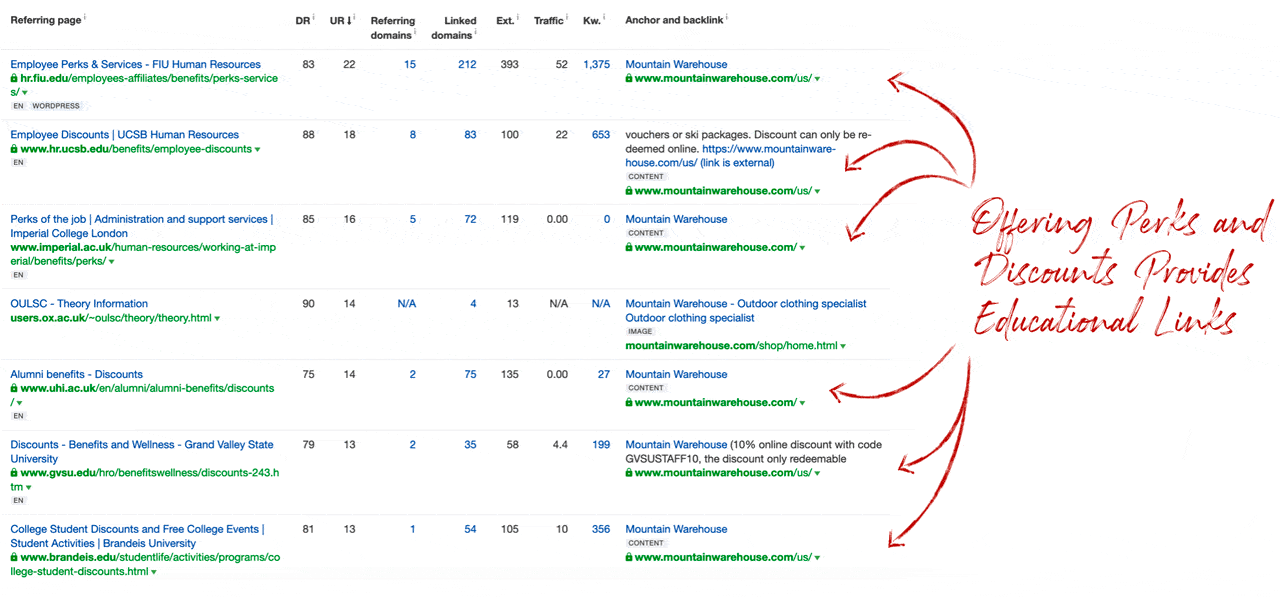 Ahrefs Backlink Profile of Mountainwarehouse.com
Ahrefs Backlink Profile of Mountainwarehouse.com
As I highlighted in my June Core Google update analysis, Google is favoring trusted links such as the ones coming from .edu and .gov links. Mountain Warehouse seems to have has capitalized on this trend.
It's Not Just Anchor Text...
While it might be easy to look at the data above and declare that Google is just being more severe on pages over-optimized with exact match anchor text, that's not exactly true.
There are many instances of websites with high anchor text ratios ranking extremely well... even in the health industry!
Here is one such example: psycom.net
 Source: Ahrefs traffic chart of Google results psycom.net
Source: Ahrefs traffic chart of Google results psycom.net
What's interesting about the psycom.net recovery is that they recovered in spite of having alarmingly high anchor text ratios on some of their best pages.
Take a look at the anchor text distribution for their depression test page.
 Source: Ahrefs anchor text distribution of www.psycom.net/depression-test/
Source: Ahrefs anchor text distribution of www.psycom.net/depression-test/
Before you go run to Twitter screaming "Proof that Google plays favorite with some health sites while penalizing others", we need to look at the actual links.
 Source: Ahrefs backlink profile of www.psycom.net/depression-test/
Source: Ahrefs backlink profile of www.psycom.net/depression-test/
These are mostly (very) high authority, low power backlinks from governmental and educational institutions. As I'll cover a little further, Google appears to have tweaked the dials on the relationship between anchor text, authority, and power.
For now, it appears as if because these links have an incredible amount of authority and relatively low power, Google is considerably more lenient when it comes to anchor text distribution.
September Core Google Update Targets
As Google updates the algorithm, some decent sites, previously unscathed, suffered massive losses for the first time. One such site is smallseotools.com
 Source: Ahrefs backlink profile of smallseotools.com
Source: Ahrefs backlink profile of smallseotools.com
While the content of smallseotools.com is good, it appears as if they couldn't resist spicing up their backlink profile. It's a shame because I feel as if the site could have attracted its own fair share of natural links.
First, let's look at the anchor text distribution for one of their pages.
 Source: Ahrefs anchor text distribution of smallseotools.com
Source: Ahrefs anchor text distribution of smallseotools.com
Looking at the anchor text, my inner monologue is screaming: "What are you doing guys! You are an SEO website, you should know better than to choose 3 anchor texts and just repeat them over and over again!"
However, as we have clearly seen in previous examples, anchor text alone is not enough to penalize a page. You need more ... (and don't worry, they deliver)
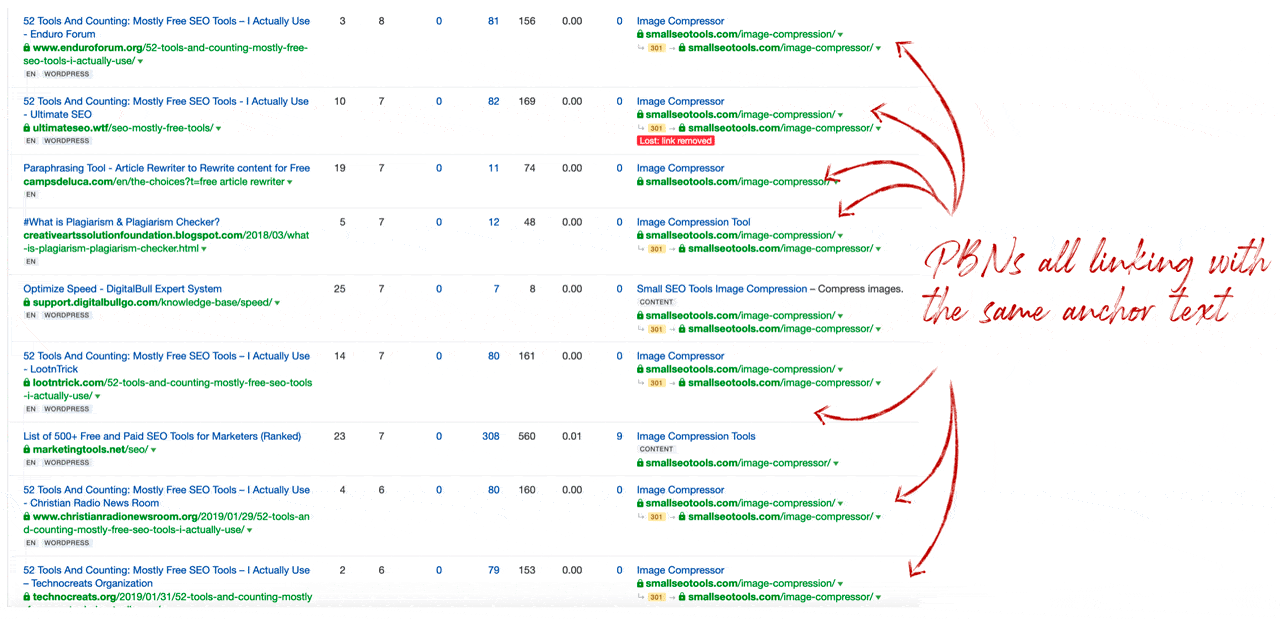 Source: Ahrefs backlinks of smallseotools.com
Source: Ahrefs backlinks of smallseotools.com
The main difference is that the majority of the incoming links originate from blatantly obvious PBNs with relatively high power to authority ratio. (While none of these PBNs would be considered especially powerful, they also don't have any authority so their power/authority ratio is closer to 1:1).
I want to make an important distinction here:
I don't believe that Google penalized this site/page because it identified PBNs were linking to it. Instead, Google appears to be looking at the culmination of links to determine that the link profile is unnatural.
The abnormal anchor text distribution, combined with relatively low authority/power links, was likely the cause of the penalty.
And penalty they received! Let's look at how it ranks now.
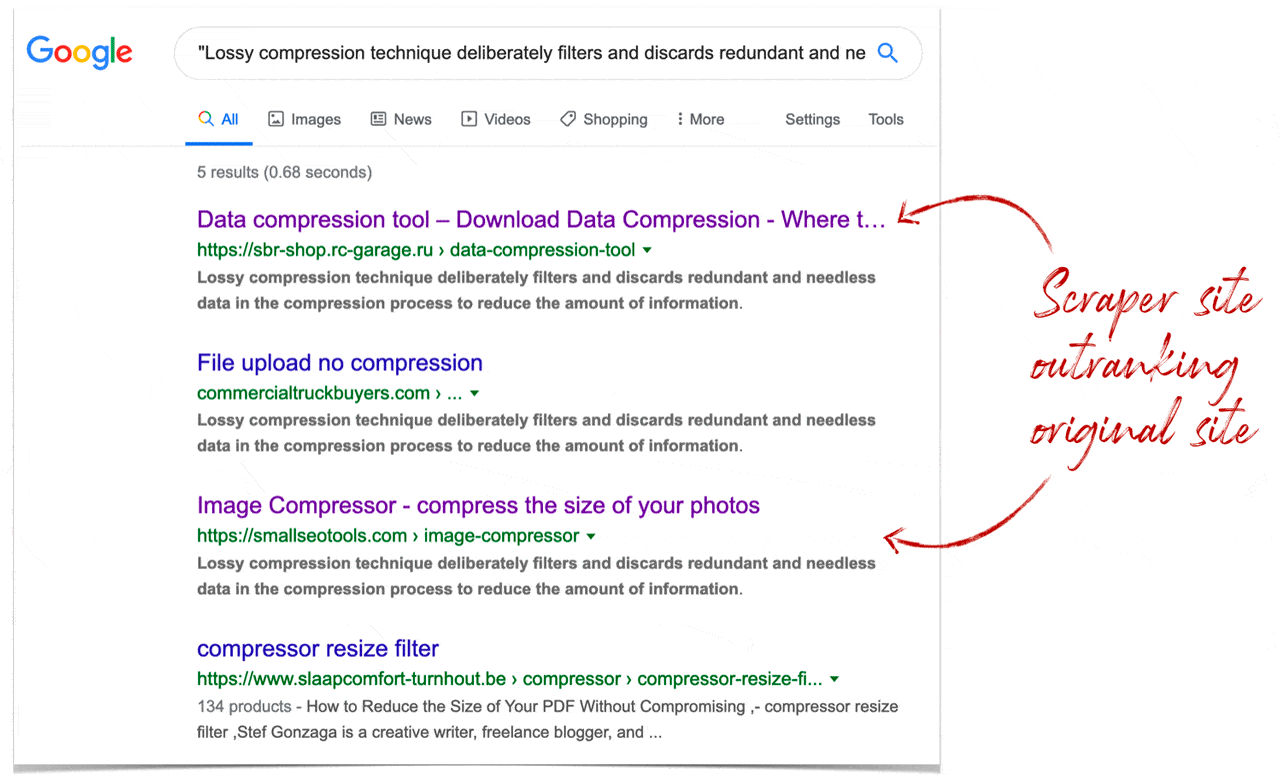 Source: Google results of scraper sites outranking of smallseotools.com with their own content.
Source: Google results of scraper sites outranking of smallseotools.com with their own content.
As it stands, the page is being outranked by scrapers for its own content. If this isn't proof that algorithmic penalties are being applied to pages, I don't know what is.
(Rant: Can you believe someone wrote an entire article on a respected SEO publication arguing that algorithmic penalties don't exist? The SeoSmallTools page has thousands of real backlinks, authority, includes the original description and a useful tool... yet it's being outranked by commercialtruckbuyers.com, a site with no authority that's scraping content. Even if the Seosmalltool page had 0 links, it should STILL rank above the scraped content.)
This is also proof that Google is no longer just "ignoring links" as they have previously claimed. Bad link profiles can hurt your page (and entire website) performance.
Smarter Link Penalties
Another example of a site being penalized for an over-optimized link profile powered by PBNs is organicfacts.net. While they have some amazing links, they also have a hefty amount of highly suspicious links that are likely the reason for the decline.
Let's take a look:
 Source: Ahrefs traffic graph of organicfacts.net
Source: Ahrefs traffic graph of organicfacts.net
The site was climbing quite rapidly until it was hit by penalties in 2018 (site quality issues) and it seemed to have resolved them, resulting in a partial recovery... only to be hit by the recent Core algorithm updates.
 Source: Ahrefs anchor text distribution of www.organicfacts.net/health-benefits/fruit/health-benefits-of-lemon.html
Source: Ahrefs anchor text distribution of www.organicfacts.net/health-benefits/fruit/health-benefits-of-lemon.html
 Source: Ahrefs anchor text distribution of www.organicfacts.net/home-remedies/home-remedies-for-cancer.html
Source: Ahrefs anchor text distribution of www.organicfacts.net/home-remedies/home-remedies-for-cancer.html
 Source: Ahrefs anchor text distribution of www.organicfacts.net/health-benefits/minerals/health-benefits-of-potassium.html
Source: Ahrefs anchor text distribution of www.organicfacts.net/health-benefits/minerals/health-benefits-of-potassium.html
According to the anchor text charts, there is evidence of link manipulation on most pages. We see exact match anchor texts being used up to 85% of the time on one of their worst hit pages!
While it would be easy to lump this site as 'just another health site that was unfairly targeted', I believe that Google updated its algorithm to better detect link manipulation... and this was the result.
Small Algorithm Tweaks: The Data
Unlike with the previous Core Google updates, we saw no major changes within the traditional ranking factors. While it's not particularly interesting to look at, the data helps to disprove false claims about the recent algorithm change.
(So if someone claims you have to rework your on-page to recover from the last update... you can point them here.)
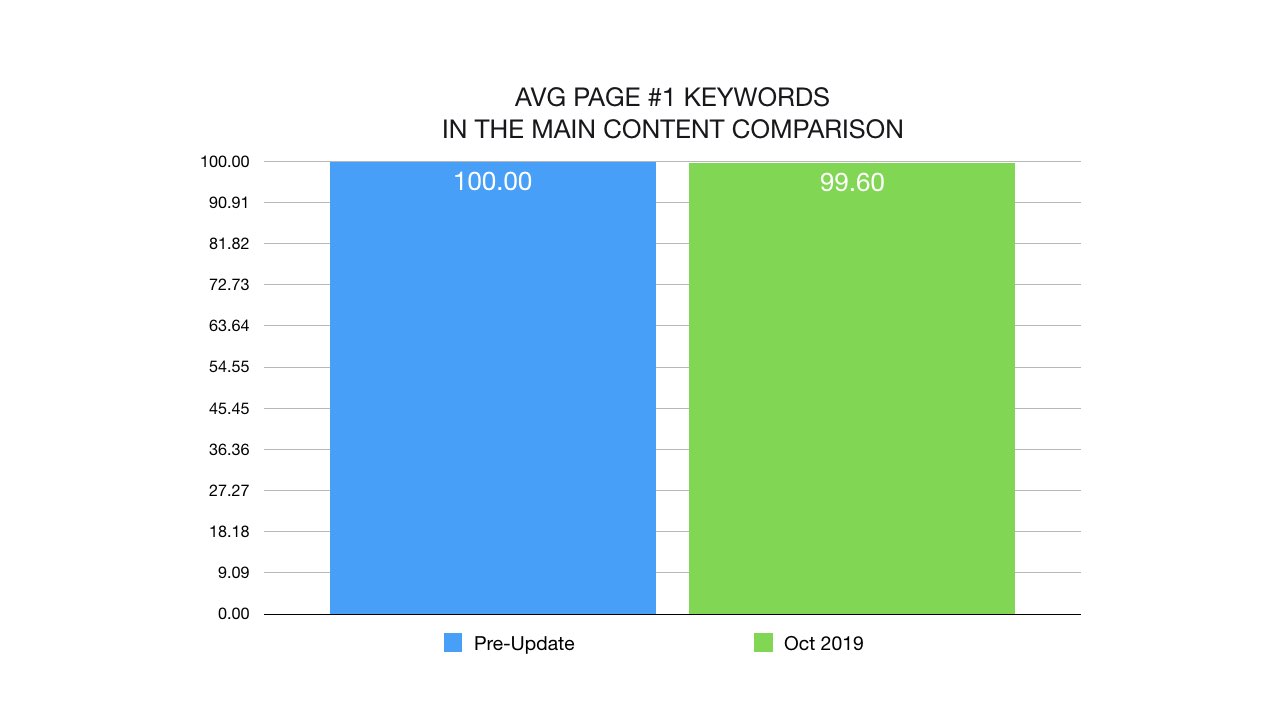
Absolutely no change here. Google doesn't appear to have changed anything with regards to on-page.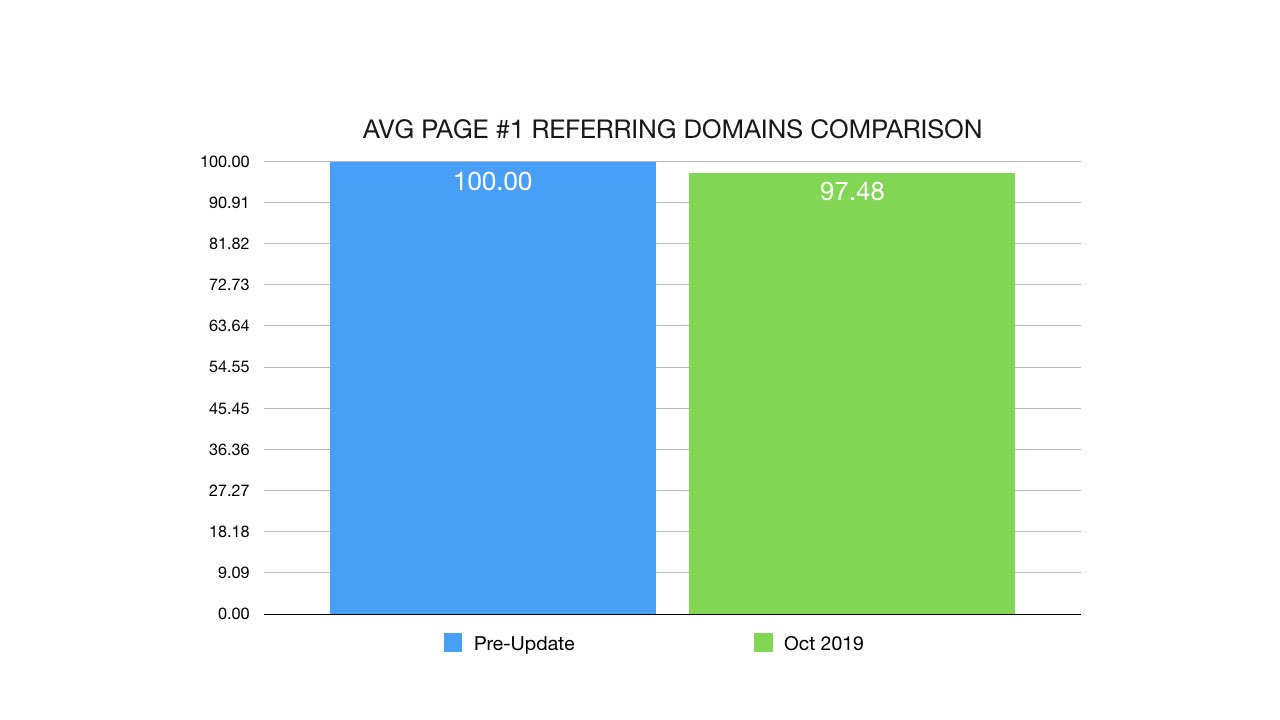
Slightly less (~3%) domains pointing to sites ranking on page 1. 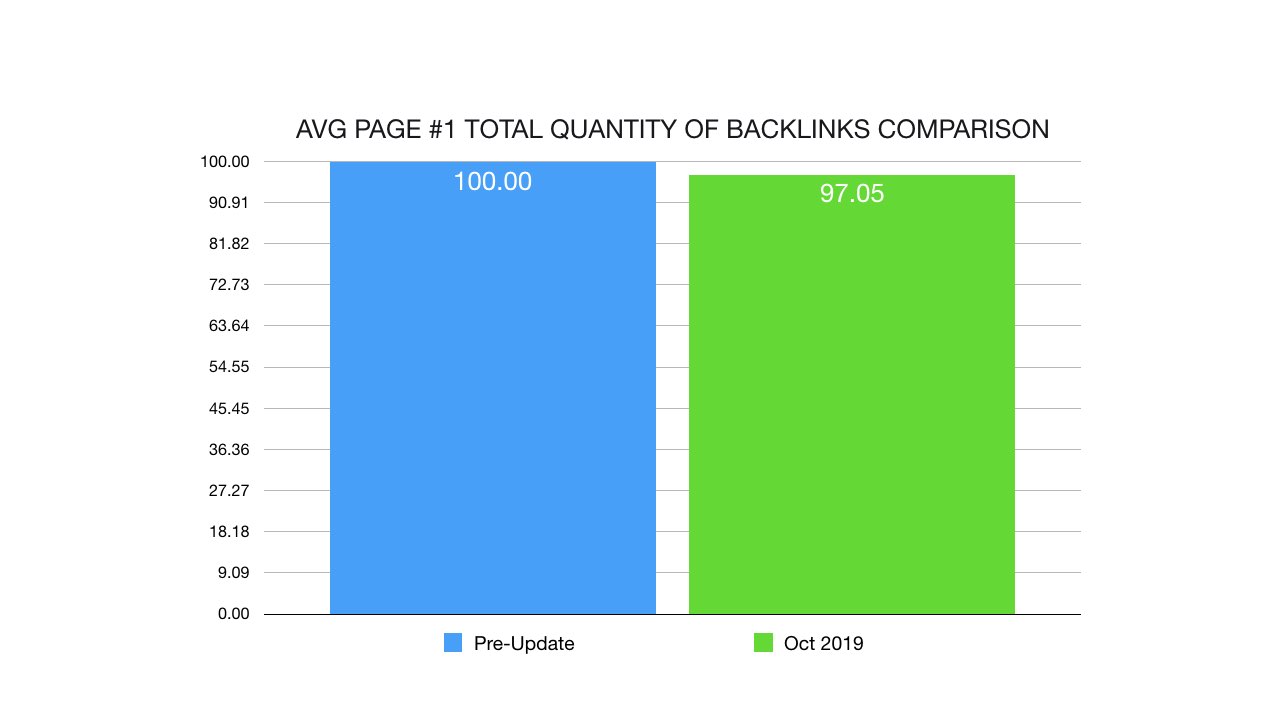
This lines up well with the quantity of referring domains, slightly less overall in September. 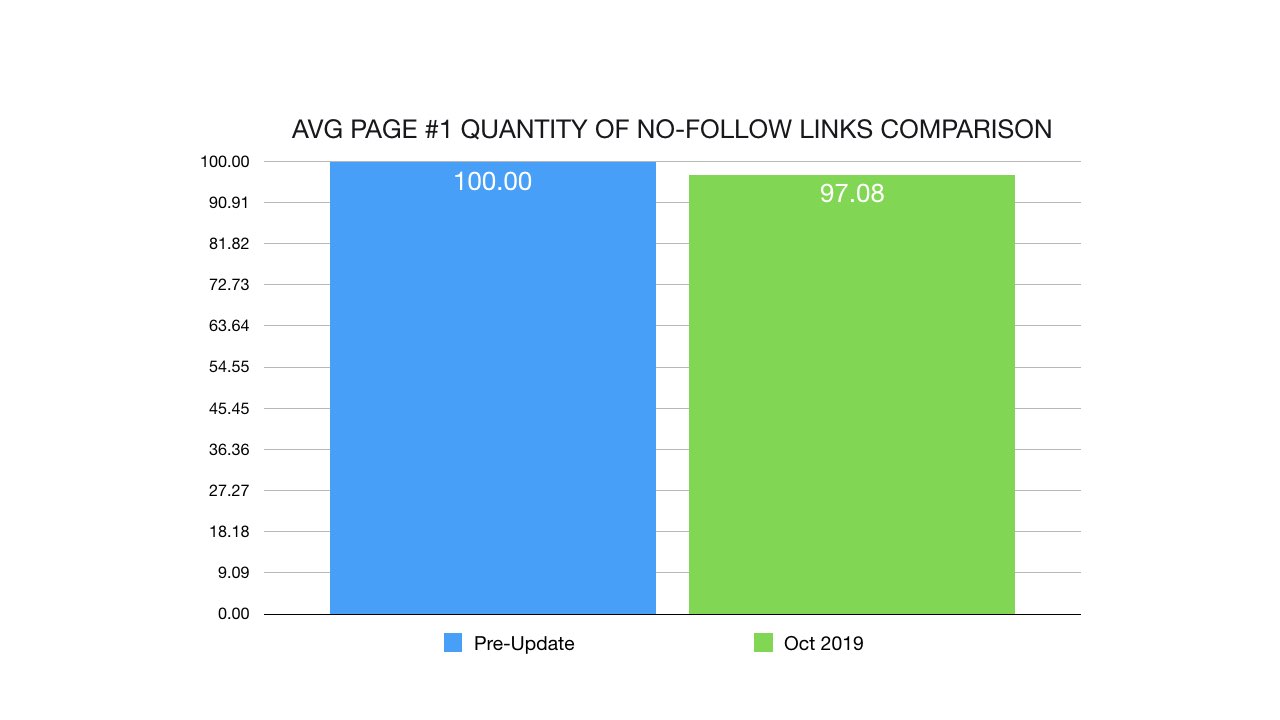
This slight reduction is in line with the overall link change we can observe.
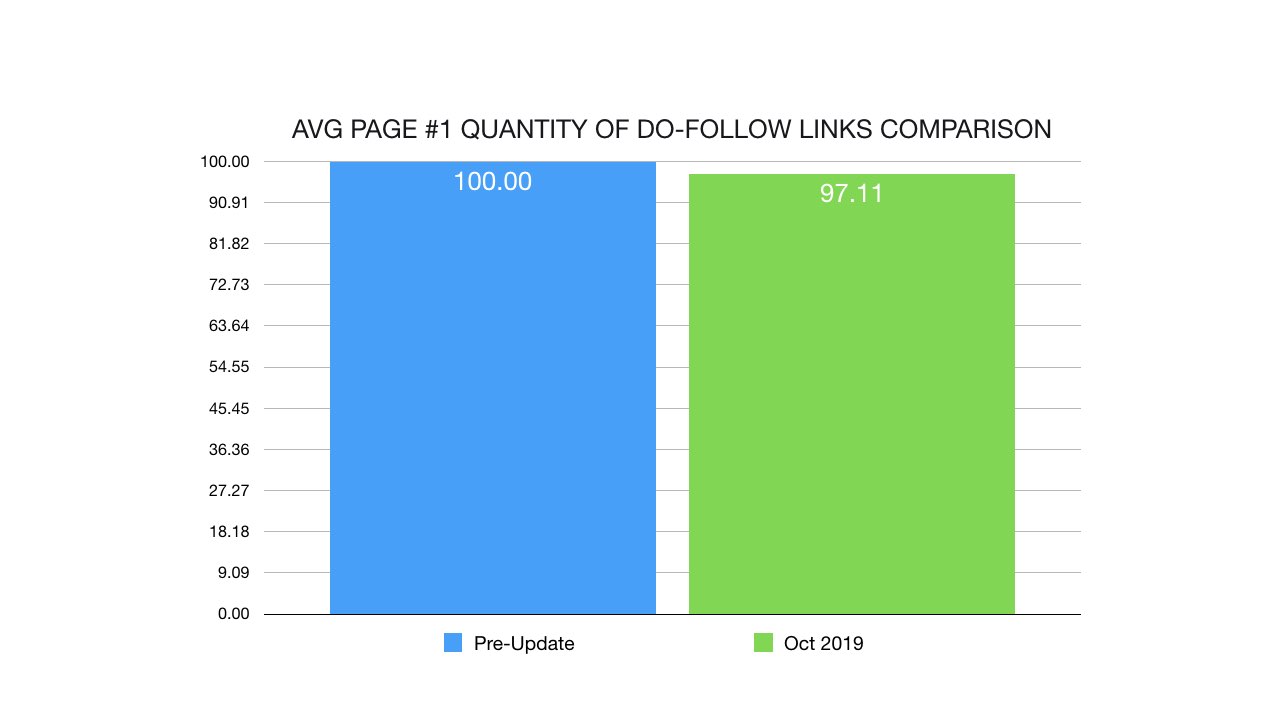
Once again, exactly what we'd expect as overall there are fewer links.
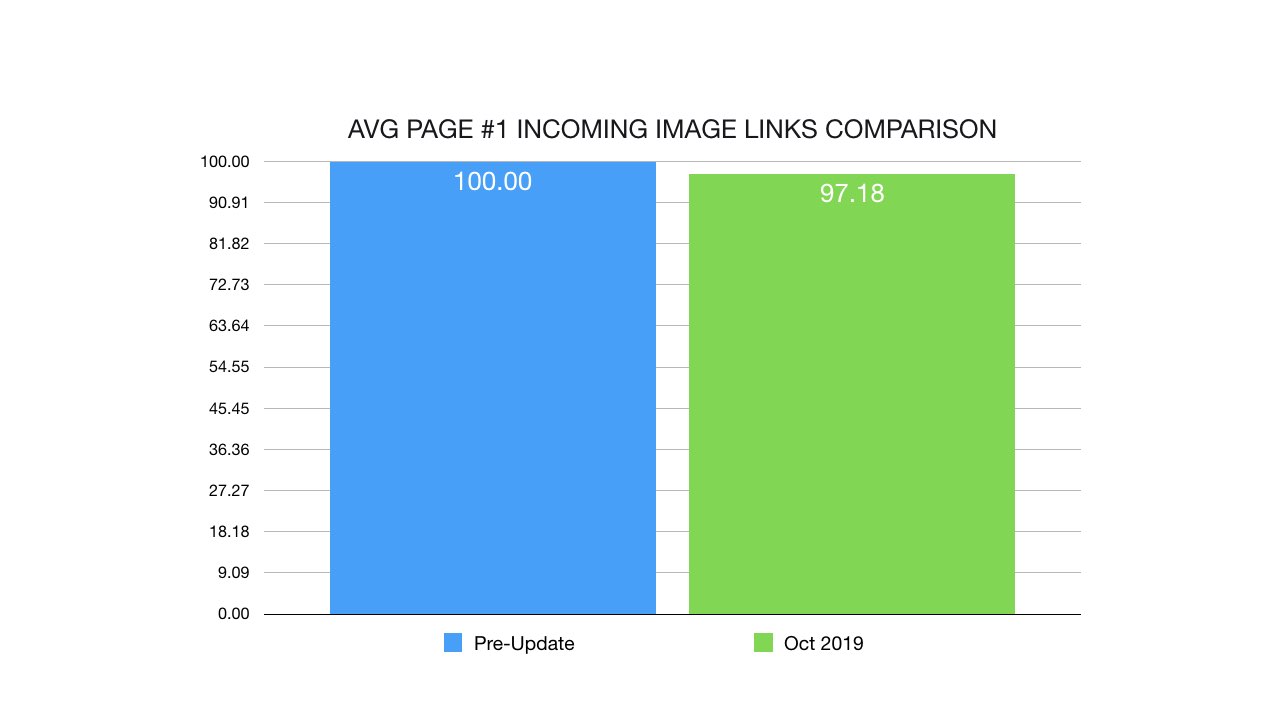 Once again, perfectly in line with the overall fewer links.
Once again, perfectly in line with the overall fewer links.
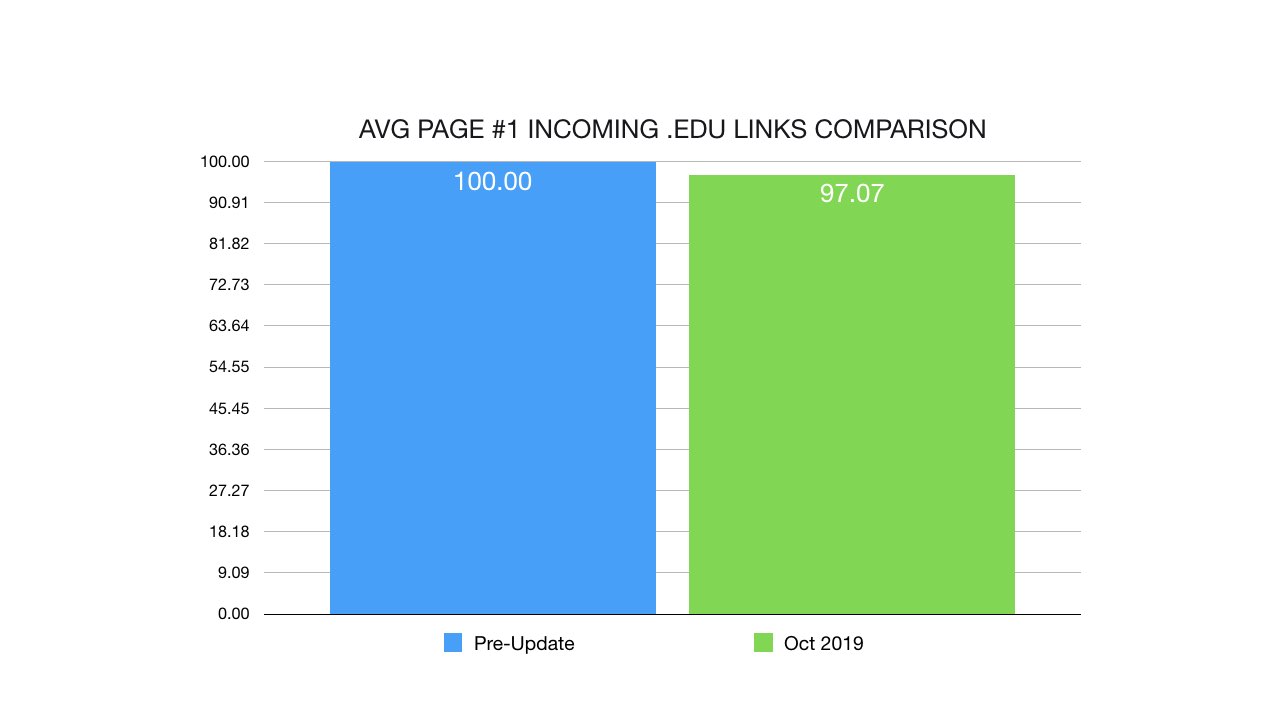 Same with .edu links. Fewer overall links mean fewer .edu links.
Same with .edu links. Fewer overall links mean fewer .edu links.
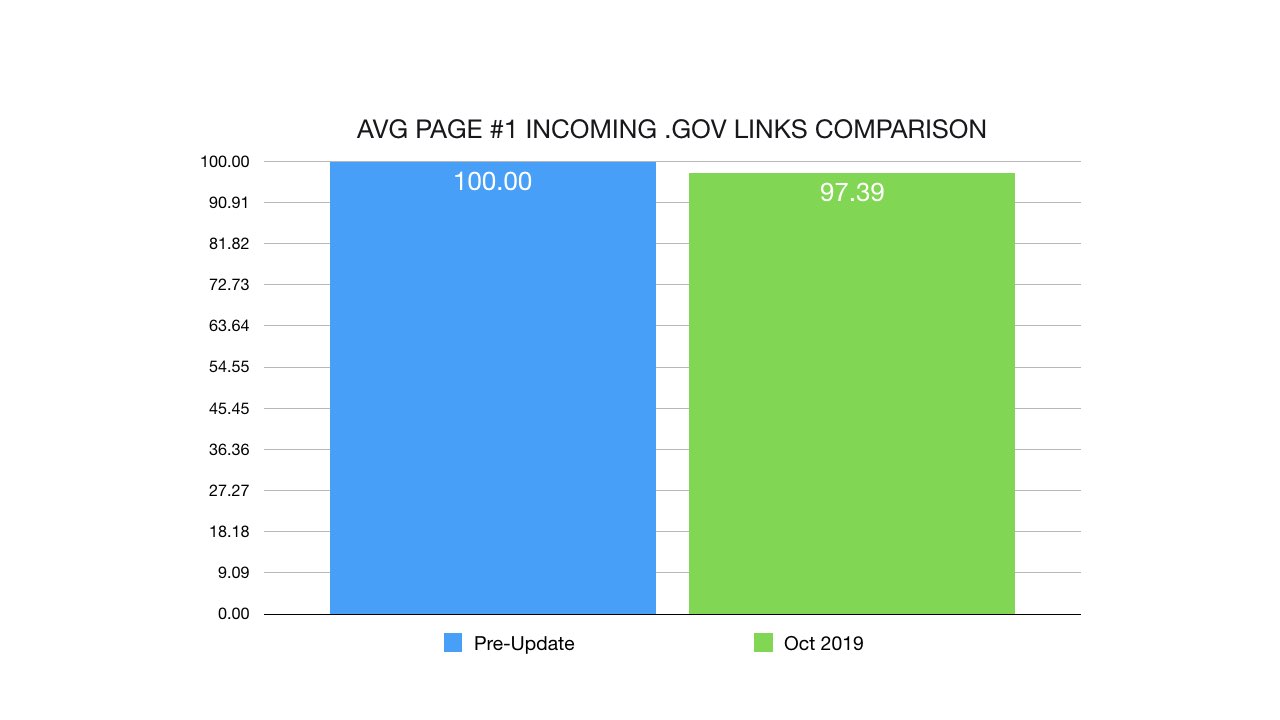
Same thing with .gov links. Fewer links overall mean fewer .gov links.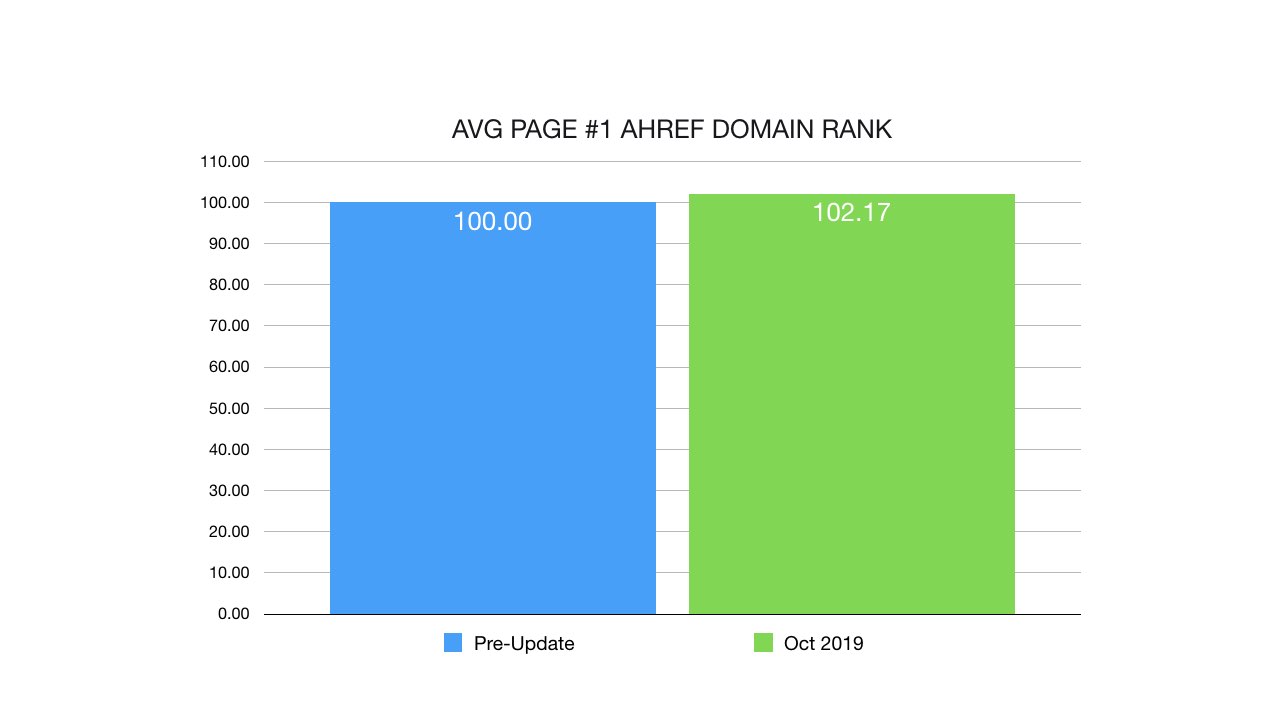
This is the only interesting piece of data because it shows that there is an increase in power while we simultaneously observed a decrease in links. This indicates that Google is rewarding fewer, yet more power, links. 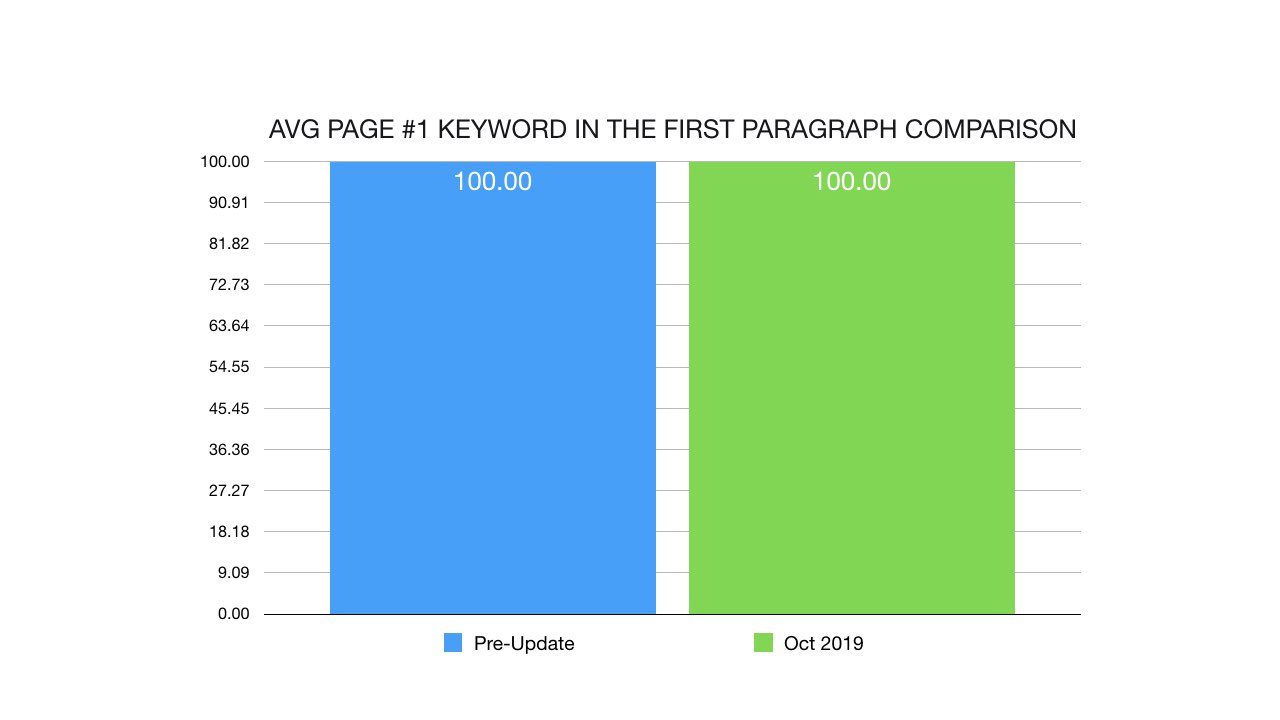
Absolutely no change here. On-page hasn't been touched.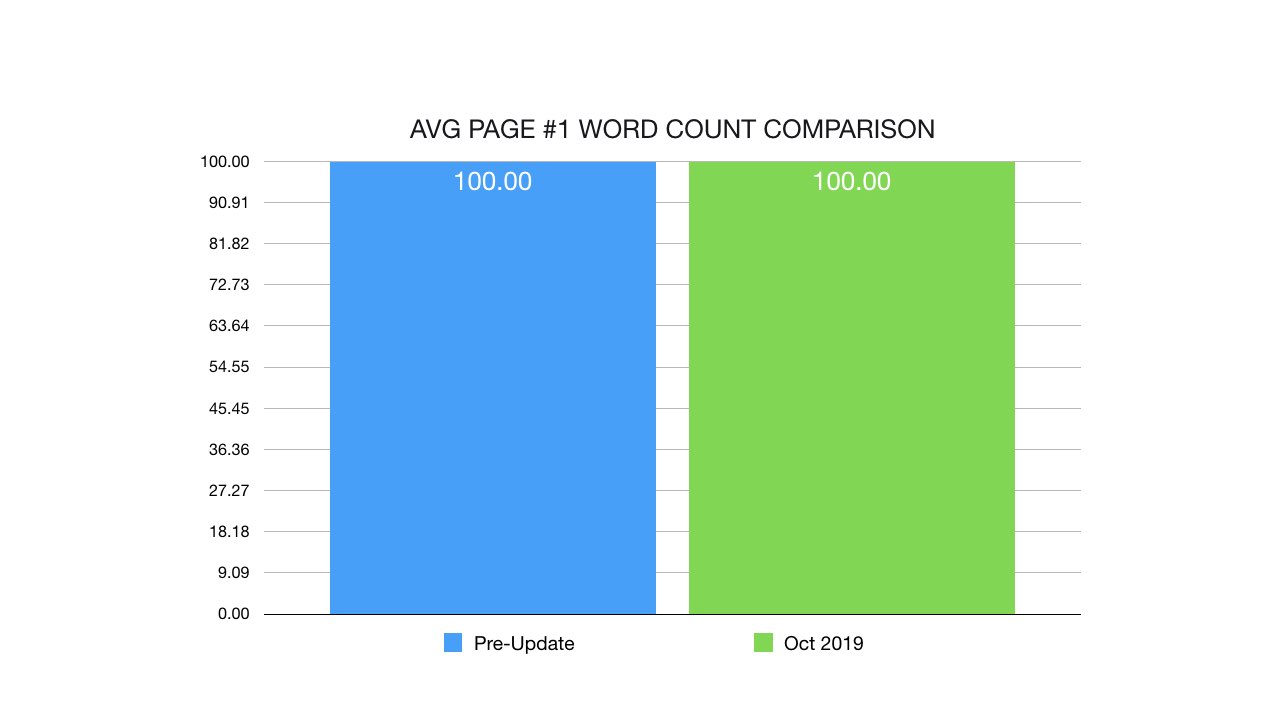
No change with article length either. 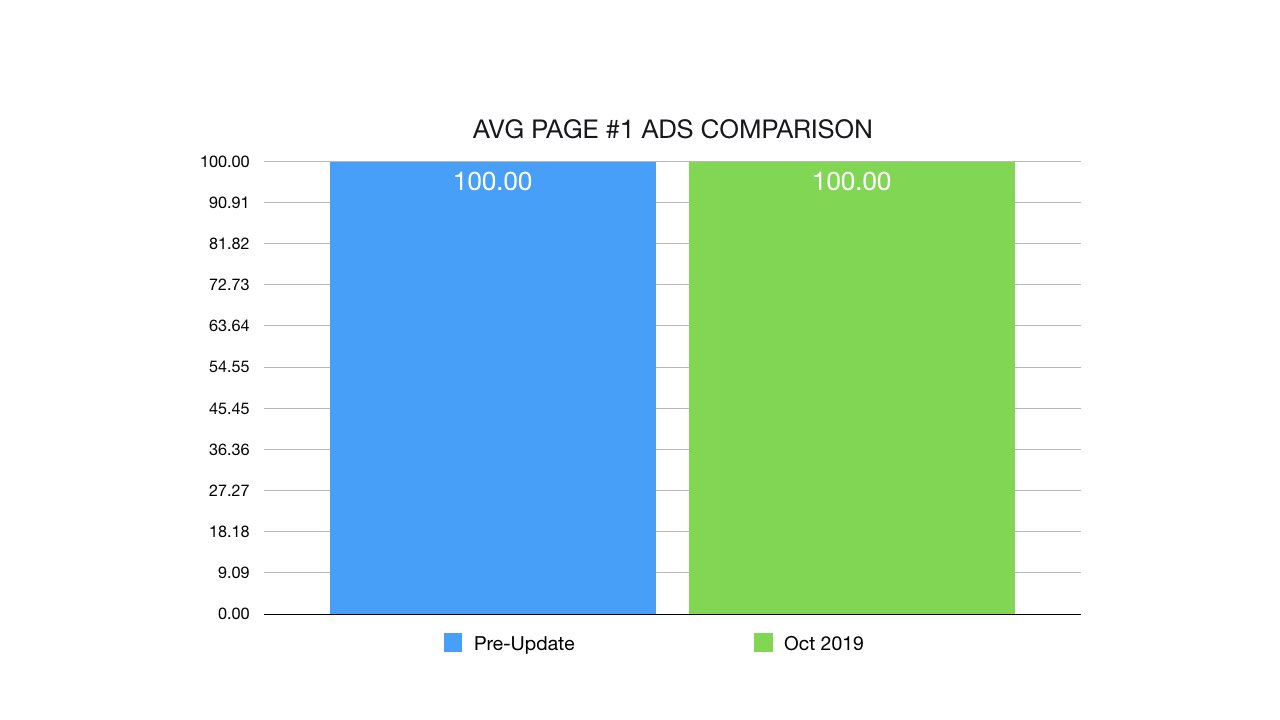
There were no changes based on the number of ads you have on your site. 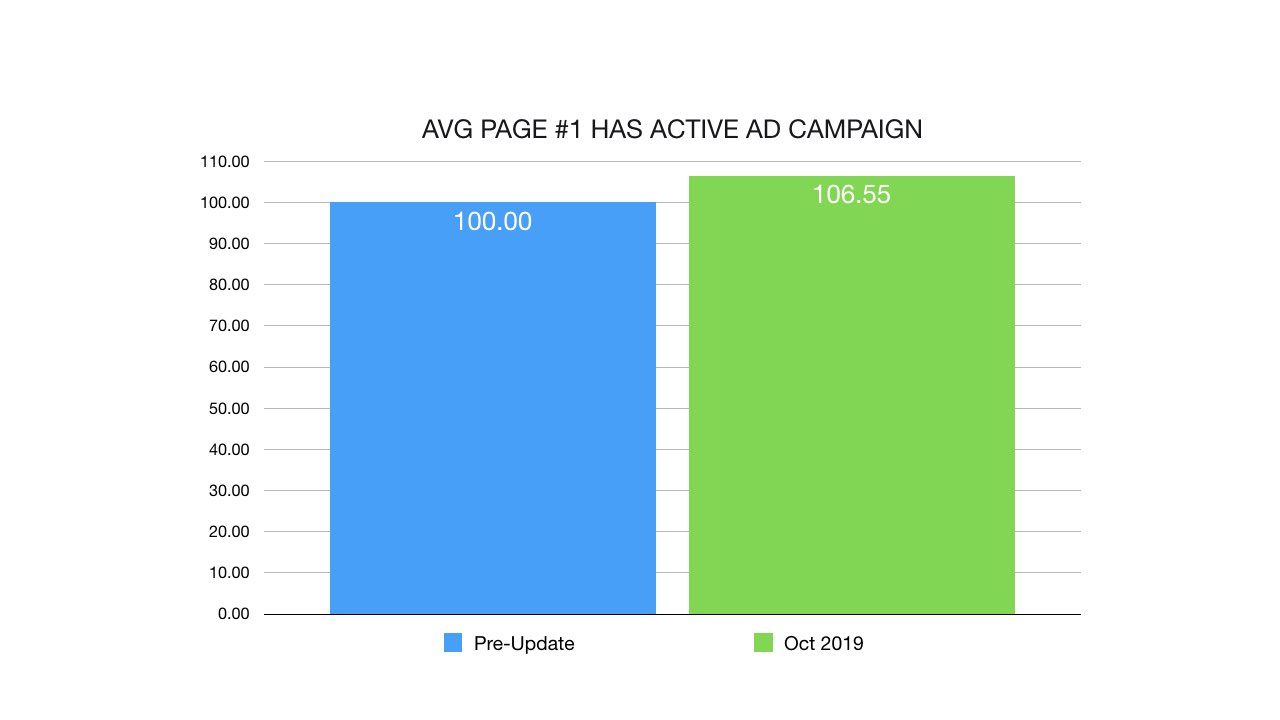
This indicates that sites with active advertisement campaigns did slightly better than those that relied solely on SEO. I don't think that this was on purpose and believe that the sites relying solely on SEO were more likely to participate in link manipulation. (I don't blame them... After all, if you rely exclusively on organic traffic, then some of the shadier methods to grow your site might seem appealing. Instead, I prefer to use methods that are both safe and powerful.)
Larger, more established brands tend to adopt safer growth methods and are more likely to receive natural links. 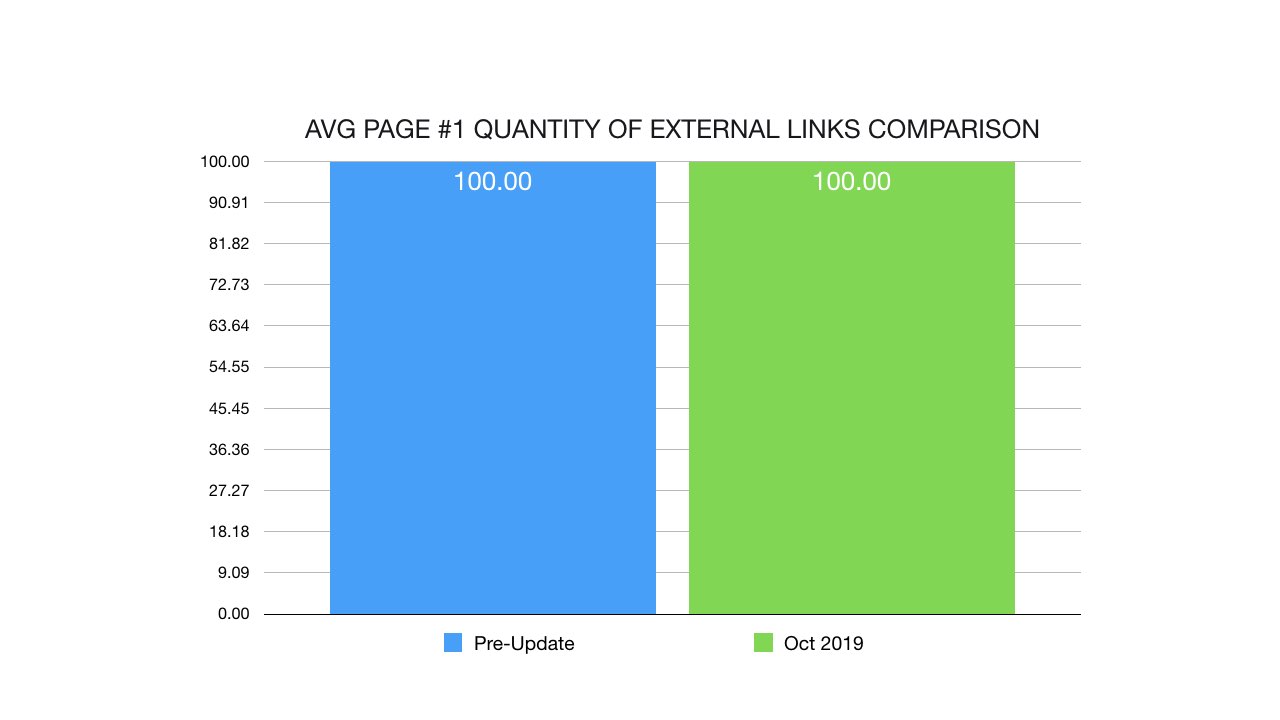
No change with regards to linking out to other sites.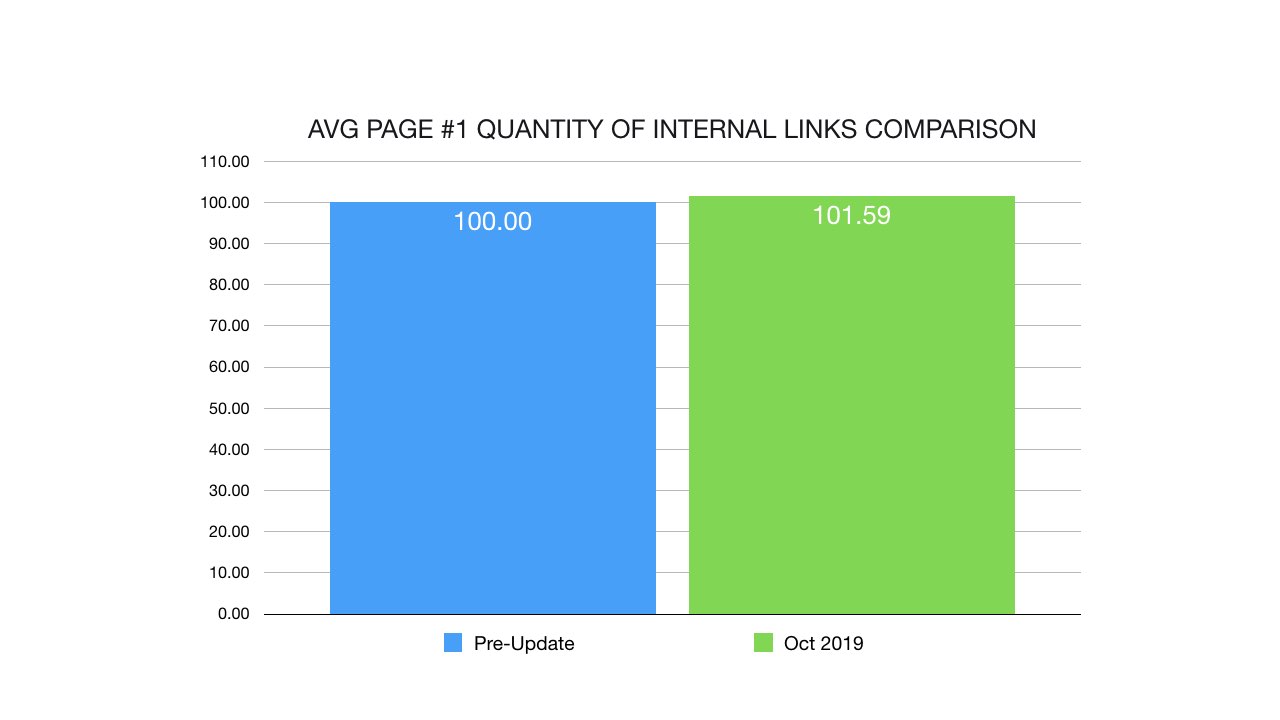
No significant change with regards to internal linking.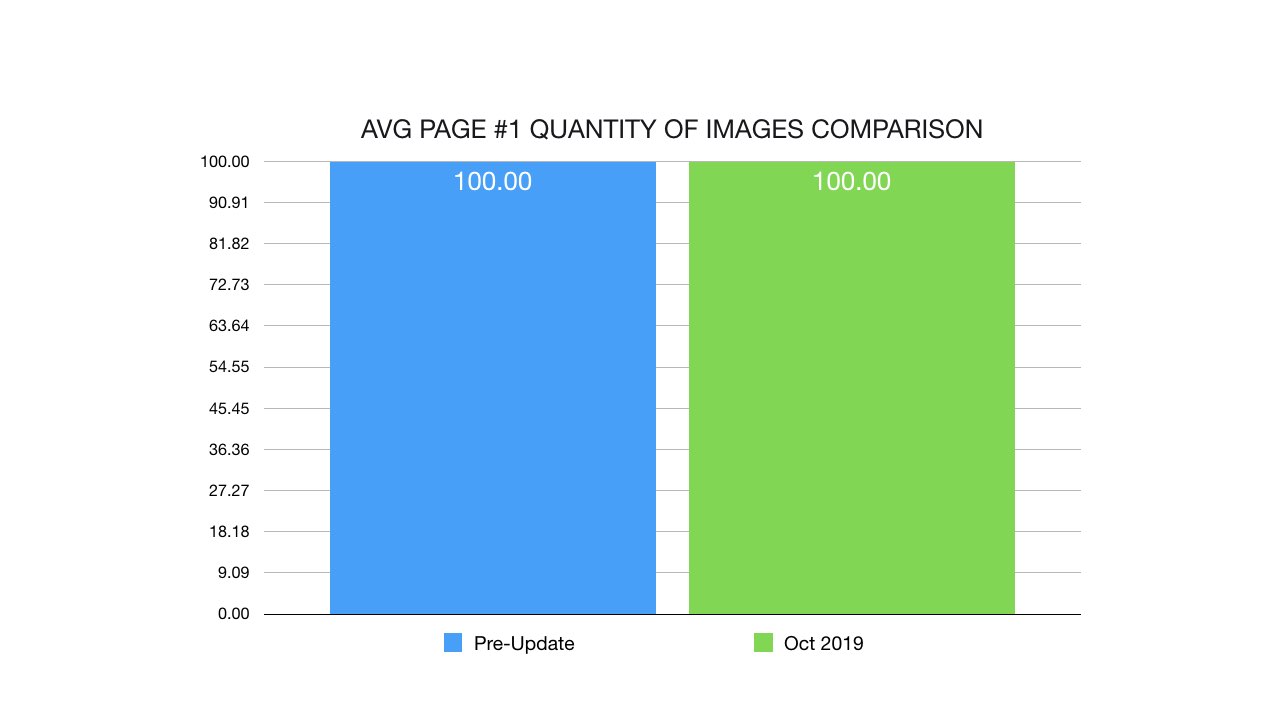
Once again, Google did not touch on-page.

Absolutely no change with bold keywords.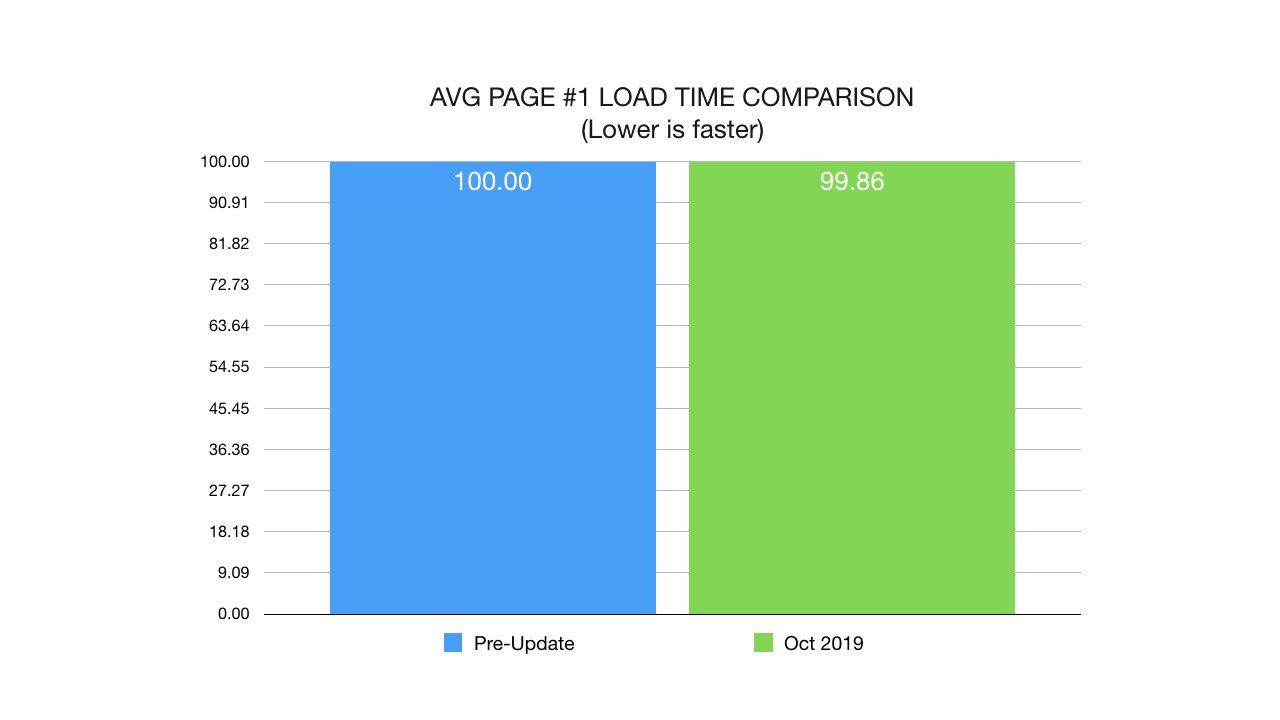
No change with page load speed.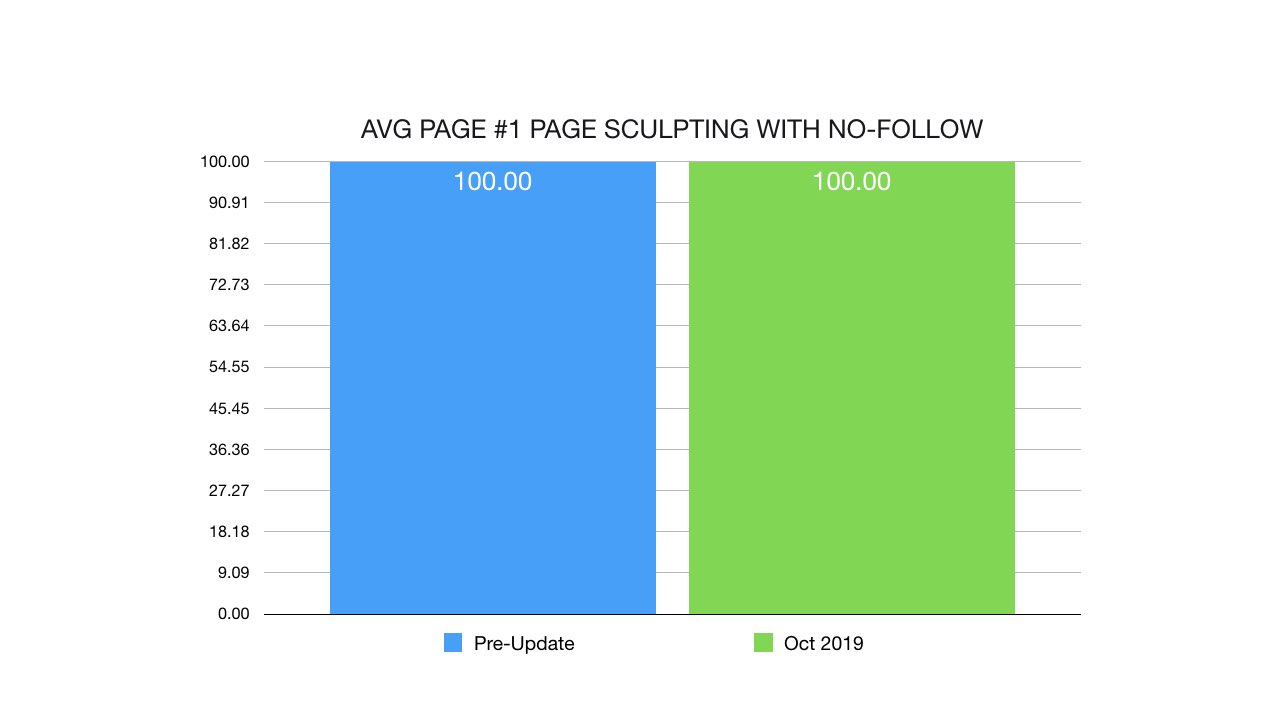
No change with on-page link sculpting. 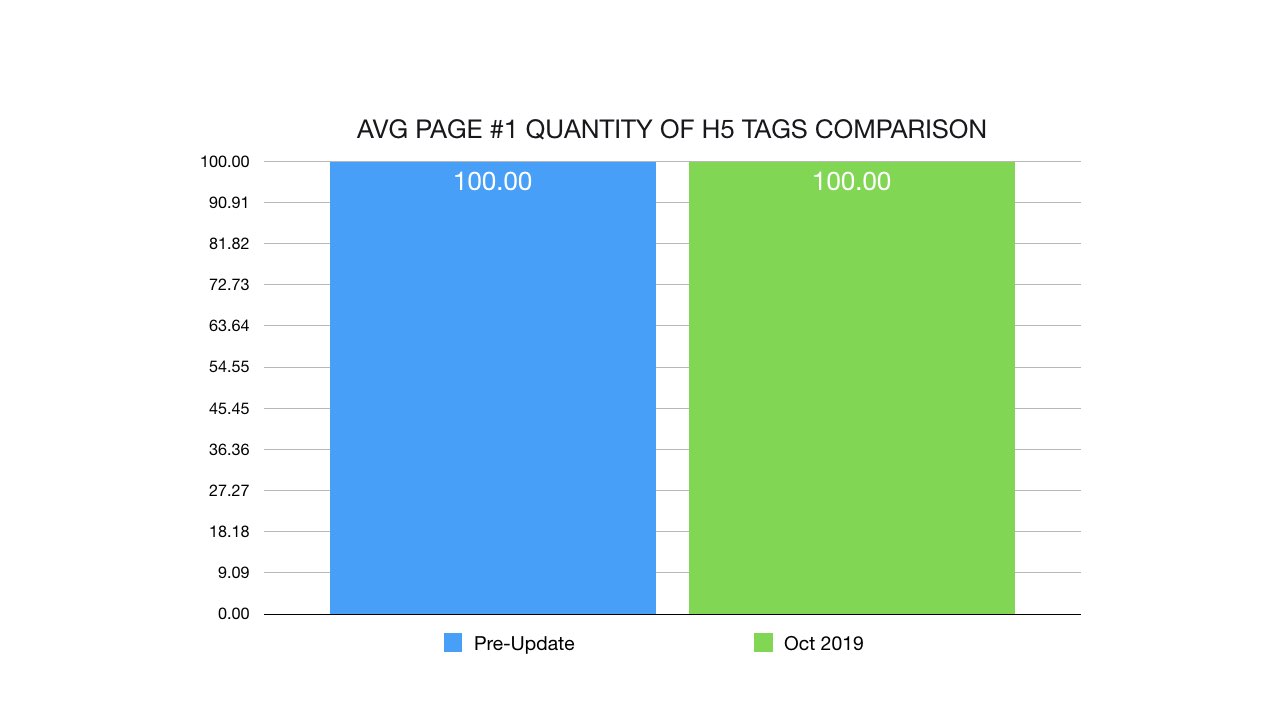
And once again, absolutely no change with regards to on-page.
The only minor change of importance is that the quantity of backlinks seems to have diminished by 3% (raw numbers of links) while the quality of backlinks increased by 3%. (Link power as measured by Ahref).
This might just be an unintended consequence of the update catching more unnatural links originating from low authority sites.
Discussion
While the data from the ranking factors show little movement, some websites saw significant traffic fluctuations ranging from full recoveries to huge penalties.
So what really changed during the September Core Google update?
In a nutshell, it appears as if Google refined and improved its spam detection algorithm to better handle edge cases regarding link manipulation.
Google is now penalizing pages with too many bad links and properly rewarding those with good links.
In-Depth Core Change
Here's what I observed with regard to the latest link changes.
Google is looking at 3 main elements to determine if a page should be penalized:
1. Link Power
2. Link Authority
3. Link Anchor text
(And possibly link relevance... but to keep it simple, I'll assume all links are relevant.)
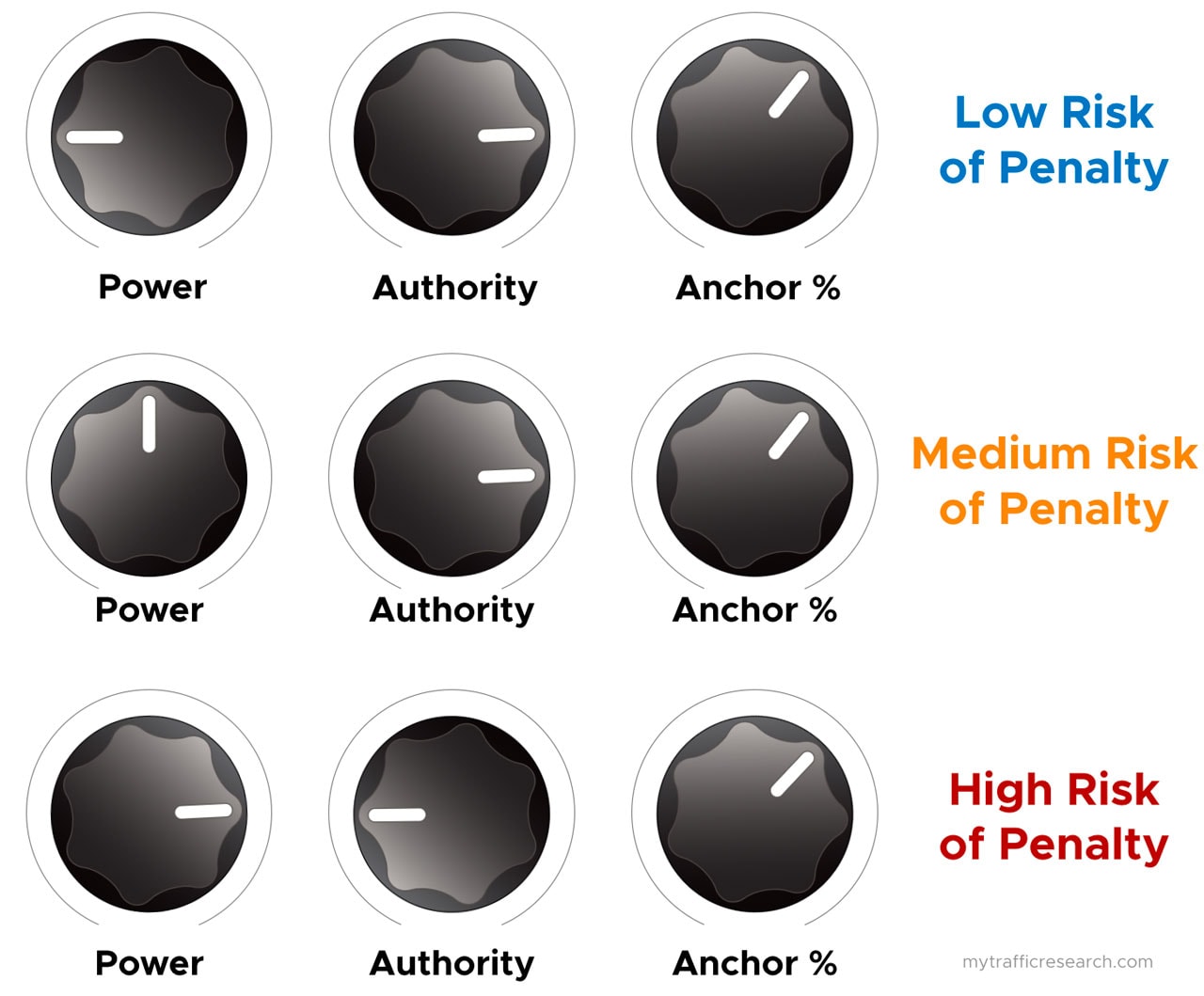
1. If the links are high power, low authority and a high proportion of commercial anchor text, the page will be penalized.
2. If the links are high power, high authority and have a high proportion of commercial anchor text, the page will be fine (as long as the ratio of authority to power is high enough).
3. If the links are low power, high authority, then you can pretty much have any proportion of anchor text and the page will be fine.
This isn't anything new as people have been looking at Majestic's Trust Flow / Citation Flow for a long time now... however it appears as if it's back in full swing after the September update. (For this study, I used Ahref's DR and UR metrics to estimate power and authority.)
In addition, depending on the niche that you're in (for example, the health niche), you might want to focus primarily on high authority. While getting powerful links is easy, authority links seem to be the true driving factor.
In other, less sensitive niches, it will be better to have a good balance of power, authority while retaining a health anchor text ratio.
Recovering From The September 2019 Google Core Update
If you've made it this far, then it should be fairly evident what you should do if you were affected by the September 2019 core update:
Address those links!
In most instances, you're likely missing authority. Links that were helping you in the past might not be helping you anymore (after the Google update) and they might even be harming you!
1. You'll want to identify which pages suffered the biggest drop.
2. Look at the anchor text distribution on those pages... and identify potentially 'bad' links that provide power without authority.
3. Remove the harmful links (disavow will likely not be enough).
As we saw within the examples, some pages are being hit with a penalty which causes scraper sites to outrank them. When you remove the harmful links, the page should at least bounce back to a normal place.
4. Finally, replace the links that were removed with high authority links.
Alternatively, if you can think you can pull it off...
Then focusing exclusively on high authority, low power links might be enough to shift the power/authority ratio in your favor. This is, of course, the riskier approach as you might just make the problem worse by getting links that seem authoritative (but really aren't).
What Webmasters Should Know
You likely already know that you vary your anchor text when building links. While this is link building 101, many webmasters still ignore this cardinal rule and suffer the consequences.
Varying your anchor text doesn't guarantee you'll be safe... but it sure does help!
Contrary to popular belief, I'm not against private blog network links. While they can be dangerous, they are still effective and can be a useful tool in some situations. Even after the latest update, many sites are still ranking great with PBN rich backlink profiles.
The main difference is that those link profiles seem natural and fly under the radar.
If you are going to go ahead and use private blogs as a source of links, you have to be careful that you aren't over-optimizing or you'll likely run into issues sooner or later. It's better to be safe than sorry.
Moving forward, you'll want to focus on acquiring high authority links as they are proving to be the driving force behind many success stories.
Closing Thoughts
If you've been negatively impacted by the latest September Core Update by Google, know that there is always hope. The Google search results are ranked by an algorithm and if you give the algorithm what it wants, it will rank you.
This change in the algorithm can be heavily exploited as I will demonstrate inside Traffic Research. There are things I can only share in private so if you're interested, join me on inside Traffic Research as I share my biggest discoveries.
Traffic Research members will have access to an training on how to exploit the latest algorithm changes for profit. Specifically, I cover how to rank your main "money site", on Google.
Exploiting the weaknesses in the current Google algorithm.
Resources Used
Tools, charts, and data used in this study:
- Traffic Research in-house data & tools.
- Scrapebox (Tool)
The swiss army knife of SEO.
- Screaming Frog SEO Spyder (Tool)
The most complete website audit software.
- SEOToolLab's Cora (Data & Tool)
The best keyword correlation software.
- Ahrefs (Website and backlink statistics) (Data & Tool)
Amazing link and website analysis software.
- SEMRush (Data & Tool)
Additional link and website analysis software.
- Majestic (Data & Tool)
Great for returning statistics on large data sets.
- Google Analytics
Amazing affordable (free if you aren't using the enterprise version) statistic software.
- Webmaster World Forums
Where I find all the horror stories of people losing most of their traffic.
- Traffic Research Forums, Emails, Slack
Resource for detailed insights on what webmasters did to recover from algorithm changes.
- Sistrix.com Winners and Losers chart
Amazing blog posts containing winners and losers.
Have Feedback?
About The Author
Eric Lancheres is credited with being the first SEO professional to discover the solution to the Panda & Penguin Updates.
In his coaching, Eric has helped dozens of entrepreneurs recover from Google penalties through his SEO consulting and regularly helps businesses raise their profits by 20-75%. Additionally, on his own, he’s created affiliate websites that sometimes generate up to 50,000 in a month, entirely on organic traffic.
These achievements have made him a featured speaker at Traffic & Conversion Summit, SEO Rockstars, & Internet Marketing Party. Although he is no longer taking on clients, he currently coaches and helps people with SEO challenges inside Traffic Research.

